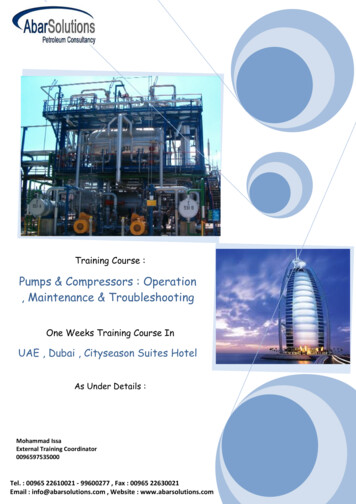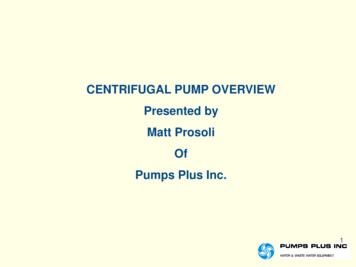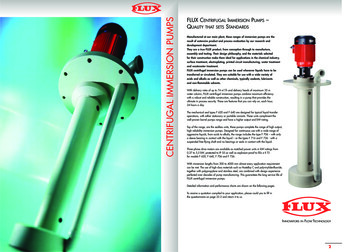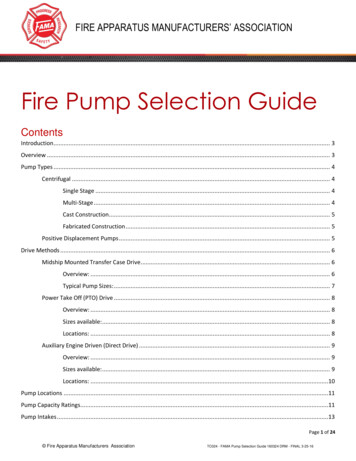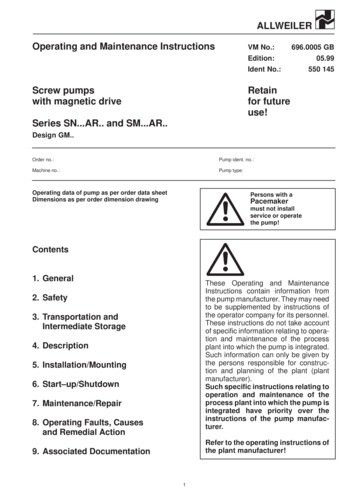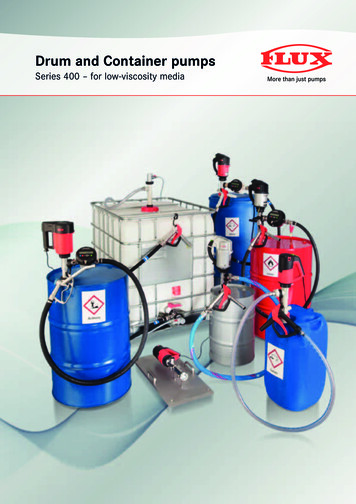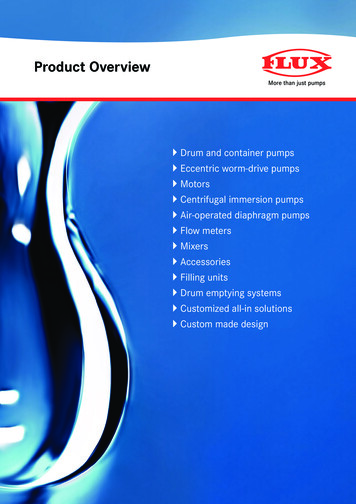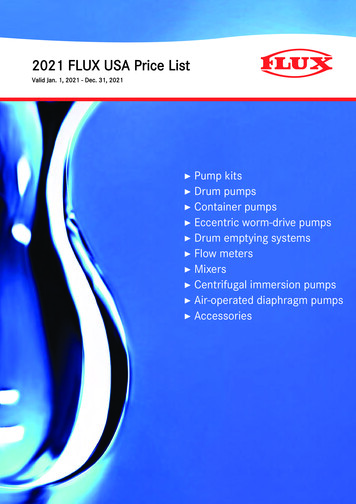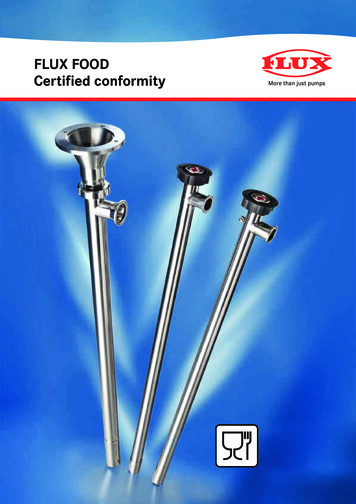
Transcription
INVESTIGATIONS ON CENTRIFUGAL PUMPS UNDER AIRENTRAINMENT CONDITIONST. Schäfer1,*, A. Bieberle1 and U. Hampel1,21Helmholtz-Zentrum Dresden - Rossendorf, Institute of Fluid Dynamics,Bautzner Landstraße 400, 01328 Dresden, Germany2AREVA Endowed Chair of Imaging Techniques in Energy and Process Engineering,Technische Universität Dresden, 01062 Dresden, Germanythomas.schaefer@hzdr.de; a.biebrle@hzdr.de; u.hampel@hzdr.deABSTRACTIn this work, high-resolution gamma-ray computed tomography was applied to investigate the two-phasedistribution in the impeller region of an industrial centrifugal pump. As an advanced tomographic methodtime-averaged rotation-synchronized computed tomography method has been successfully applied inaddition to conventional radiography to investigate the internal gas-liquid two-phase flow. The formationsof the gas holdups in different heights near to the shaft and in the impeller wheel, depending on theinjected gas volume fraction, have been analyzed and the consequences on the pump operation have beendiscussed. Furthermore, internal accumulated gas holdup pattern and pump performance depending on theinlet gas volume fraction and inlet flow regimes have been investigated. Thus, influences of different flowregimes on the internal gas-holdup have been identified. Moreover, calculated gas holdup profiles in thesix impeller chambers of the impeller wheel have been analyzed along selected streamlines. As a result,typical holdup profiles have been evaluated.KEYWORDScentrifugal pump, advanced Ȗ-ray computed tomography, gas entrainment, phase fraction visualization1. INTRODUCTION1.1. Centrifugal pumpsCentrifugal pumps are widely used in process industries and power engineering, e.g. in refineries asfeeding pumps or in power plants in cooling circuits. In nuclear power plants they are operated in variousplaces and particularly in safety-related functions, like emergency core cooling. In chemical industriesthese flow machines are used to transport inorganic and organic liquids as well. Furthermore, otherapplications of centrifugal pumps can be found in water treatment, oil industries, food production andagriculture, heating installations or shipbuilding industries.In general centrifugal pumps consist of an impeller and a diffusor. The rotating impeller is used to transferthe mechanical energy from the driving shaft into the fluid. This occurs by flow acceleration and flowredirection. Thus, the kinetic energy of the fluid increases. The diffusor is necessary to convert theimparted kinetic energy of the fluid into pressure energy. This leads to an increasing pressure, whichdrives the flow.Though simple in design centrifugal pumps offer advantages, like high operational efficiency and lowenergy consumption, smooth and steady operation and high reliability. They produce a very steady,NURETH-16, Chicago,NURETH-16,Chicago, IL,IL, AugustAugust 30-September30-September 4,4, 20152015785785
consistent and even flow, which is requested for many applications. Further advantages are their higherdischarging capacity, higher operating speeds and their ability for lifting highly viscous liquids such as oiland sewage water, sugar molasses or paper pulp. Due to these advantages they are the favorite choice inmany applications.However, centrifugal pumps also come with some deficiencies. Their major disadvantages are thetendency to vortex formation at suction side, vibrations and noise. Also the possibility of occurring ofcavitation at higher flow rates is problematical. As reported by [1] the cavitation characteristics andperformance of a pump is influenced by the blade number, which is one of the most important designparameters of centrifugal pumps.1.2. Gas entrainmentGas entrainment as well as internal steam generation by cavitation is known as being detrimental andcritical to the operation of centrifugal pumps, since they were primarily designed for single phaseoperation. Gas entrainment decreases the efficiency of the pump and can result in negative influences onthe plant performance. Unfortunately it is not always possible to avoid the entrainment of gas. Forinstance, gas entrainment may occur in situations, where water is conveyed from a reservoir with ashallow liquid height. There hollow vortices may form as a consequence of low liquid level and preexisting fluid swirling. Particularly, such a situation may be prevailing in nuclear power plants, e.g. whenemergency cooling water is taken from a liquid reservoir, like the condensation chamber. Thus the effectsof gas entrainment on centrifugal pumps have to be analyzed and its effects on the flow regime as well asthe influences on the pump characteristics have to be clarified, with respect to the general plant safety.1.3. Previous workSeveral studies have been made, investigating the behavior and characteristics of centrifugal pumps undergeneral working conditions [2-4]. Thus, the adverse impacts of entrained gas on the characteristics ofcentrifugal pumps were observed. Presence of gas in pumps may lead to abrasion at impeller blades,strong vibrations with damaging of bearings and loss of cooling for shaft and bearings and early fatigue asa consequence. At least the presence of gas will lead to decreasing pump performance even to the point ofabrupt collapse of flow rate.Up to now, the effects of air entrainment have been investigated under various operating conditions [5-6],but the characteristics of gas phase fraction accumulation inside centrifugal pumps, particularly in theimpeller and nearby the shaft seal region, are insufficiently understood. As reported by [7] the gasbehavior depends on distributions of static pressure and liquid velocity in the impeller passages. Already,the changes in pressure, velocities and void fraction distribution under two phase flow conditions werecalculated, solving the Reynolds-averaged Navier-Stokes equations for two phase flow in the impellerregion of a centrifugal pump [8]. Flow-induced pressure pulsations, vibrations and the resulting noisewere investigated in a centrifugal pump [2]. Several experiments on cavitating flows in a centrifugalpump with two dimensional curved blades were conducted in the past, to find out the cavitationcharacteristics and to develop a numerical model to predict the cavitation behavior [9]. Recently, the flowconditions during fast start up which can cause cavitation were investigated in a centrifugal pump withopen impeller [10] and in a modified centrifugal pump using x-ray measurements [11]. For different flowconditions simulations of cavitating flow in a centrifugal pump were conducted [12]. Here theinvestigations were focused on low flow rates. Related to this, the unsteady flow structure which appearsfor example in pressure fluctuations were investigated under single phase conditions for a low specificspeed centrifugal pump using a numerical model [3]. Moreover, studies on different impellers werecarried out, to optimize the hydrodynamic performance of a centrifugal pump by an improved impellerdesign [13-14].NURETH-16, Chicago,NURETH-16,Chicago, IL,IL, AugustAugust 30-September30-September 4,4, 20152015786786
However, the investigations on centrifugal pumps, which are designed for single phase flow, but workingunder two phase flow conditions, have to be continued, since the behavior of the appearing flow and itseffects on the characteristics of the centrifugal pumps are insufficient understood. Experimentalinvestigations on pump characteristics and performance breakdown at different flow conditions under airentrainment conditions are essential to increase the efficiency of centrifugal pumps. Based on theseanalyses, advisable working conditions can be defined and the geometric design can be improved. Alsofurther investigations and experiments which deliver temporal and spatial high-resolution data sets arerequired. They may help to identify characteristic flow structures in more detail. The results of theseinvestigations are beneficial in the field of scientific research to get a better understanding of the physicsof the multiphase flow which is helpful for example to find better flow models for computational fluidmodelling. But they are also significant in industries for plant operators and pump manufactures since itcan be used to avoid operational problems, increasing the plant energy efficiency or for the developmentand engineering of optimized pumps.2. MATERIALS AND METHODS2.1. Experimental SetupFor investigations on centrifugal pumps, a hydraulic test facility was designed and built up. Thus, twophase flows with defined adjustable gas volume fractions can be provided at the suction side of thecentrifugal pump. Additionally, two specific gas phase fraction arrangements are selectable.In general, the hydraulic test facility consists of two main components, which are a supply part and amodular test section. A two staged separator which is used as liquid feeding reservoir as well as for theseparation of the recirculated two phase flow is integrated in the supply part. Furthermore, a heatexchanger (C200 301-1, FUNKE, Germany) is implemented. The test facility is instrumented with amagnetic inductive liquid flow meter (MAG 1100, Siemens, Germany) and a temperature sensor (PT100)to measure the liquid temperature TL. The temperature is controlled by a thermostat (Unistat Tango) incombination with the heat exchanger. Thus, isothermal conditions are guaranteed during the experiments.Furthermore, the pressure at the suction side of the centrifugal pump psuc as well as the differentialpressure across the pump ǻppump is measured.NURETH-16, Chicago,NURETH-16,Chicago, IL,IL, AugustAugust 30-September30-September 4,4, 20152015787787
)LJXUH 6LPSOLILHG VFKHPH RI WKH PRGXODU SXPS WHVW VHFWLRQ ZLWK PXOWL-PRGH JDV LQMHFWLRQ PRGXOH DQG LQYHVWLJDWHG FHQWULIXJDO SXPS The centrifugal pump, which is under investigation (Etachrom BC 032-160/074 C11, KSB, Germany), isinstalled in a way, that its impeller wheel is horizontally aligned. The centrifugal pump has a DN 50 inletand a DN 32 outlet. It drives the flow loop of the experimental rig and is part of the modular pump testsection (Figure 1).Additionally, another essential component is the multi-mode gas injection module which is alsoillustrated in Figure 1. It consist of a gas injection ring with four hole type nozzles, for the disperseinjection of gas (purified compressed air). The nozzles are arranged symmetrically around the pipe. Thegas injection ring can be combined with a special designed swirl element. Thus, a dispersed gas-liquidtwo-phase flow as well as a two-phase vortex flow with formed gas core can be generated at the suctionside of the centrifugal pump. The injected gas flow rate QG is controlled by a mass flow controller (FMA2600, OMEGA Newport). It is calculated according toఌܳୋ ൌ ଵିఌ ܳ ݂ Ͳ ݎ ߝ୧୬ ͳ ܽ݊݀ ܳ ് Ͳ , (1)using the current liquid flow rate QL and a given inlet gas volume fraction İin. The facility can becompletely controlled with a programmable logic control (SPS-ILC 350 ETH, Phoenix Contact) via aweb interface. The experimental conditions data, like flow rates, pressures and temperatures, are stored ina data base synchronized to the tomographic scan data sets by time stamps.2.2. High-Resolution Gamma-Ray Computed Tomography ScannerHigh-resolution gamma-ray computed tomography (HIRE-CT) has been chosen to determine the gasphase distribution in an industrial centrifugal pump quantitatively, since it was already successfullyNURETH-16, Chicago,NURETH-16,Chicago, IL,IL, AugustAugust 30-September30-September 4,4, 20152015788788
applied on hydrodynamic test facilities, e.g. in bubble columns [15-16], axial pumps [17], fluid couplings[18-19], trickle bed reactors [20] and electrically heated rod bundles [21].The HIRE-CT scanner is able to scan objects with a typical spatial resolution of about 2 mm and with amaximal object diameter of up to 700 mm. A multi-pixel detector arc, consisting of 320 scintillationdetectors (8e-6 sqm active area) is arranged in a horizontal plane, surrounding the scanned object. It isaligned with an isotopic source (137Cs, energy 662 keV, activity 180 GBq) to measure transmittedgamma radiation and, thus, provides projection raw data sets for subsequent image reconstruction.Especially the usage of isotopic sources, emitting high mono-energetic gamma photons, allows analyseswithin industrial-authentically operated facilities since wall thicknesses of many centimeters of steel canbe easily penetrated. As a result, 2-D or 3-D material distributions can be obtained contactless andwithout interfering with the internal processes. Further details of the used HIRE-CT scanner can be foundin [22].2.3. Scanning Modes and Data ProcessingConventional radiography scanning mode [23] and time-averaging rotation-synchronized computedtomography scanning mode [17] have been applied. For the conventional radiography scanning mode, thecentrifugal pump is positioned in the HIRE-CT scanner between the isotopic source and the detector arc.The isotopic source emits gamma radiation which is differently attenuated by the scanned object(centrifugal pump), depending on its structure and materials. The penetrated radiation represents thematerial distribution of the object along various ray paths as a projection of the attenuation properties. It isdetected by scintillation detectors of the detector arc, for an adequate time, and subsequently recorded.Afterwards, this procedure is repeated for several heights, which means closely spaced, intersectingscanning planes through the object (vertical spacing: inside the impeller wheel 2 mm, else 3 mm).Eventually, all recorded projections from different scanning planes are appended and thus, a twodimensional radiographic image (attenuation image) of the scanned object is obtained.To obtain cross-sectional tomographic images time-averaging rotation-synchronized computedtomography scanning mode has been used. Differing from conventional computed tomography scanningmode, there is no mechanical rotating source-detector unit required. Instead, the inherent rotation of thepump impeller wheel is directly used to generate the necessary set of projections of the scanned object(Figure 2). Therefore, the projection data acquisition is synchronized to the impeller rotation positon. Thiscan be realized with a HALL sensor, which is installed closely to the driving shaft of the centrifugalpump.While the conventional radiography delivers integral gas phase fraction distributions according to thescanning planes in different heights, the time-averaging rotation-synchronized computed tomographyscanning mode discloses the spatial distribution of the gas phase fraction, which is accumulated in therotating impeller wheel of the centrifugal pump.NURETH-16, Chicago,NURETH-16,Chicago, IL,IL, AugustAugust 30-September30-September 4,4, 20152015789789
Figure 2. Principle of time-averaging rotation-synchronized computed tomography scanning mode.For tomographic image reconstructions algebraic reconstruction technique (ART) according to [24] isusedሺఛାଵሻɊ ǡ ൌሺఛሻɊ ǡ ಿ ɉಿ ሺഓሻೣ σ ǡೕǡ ǡ ቀா ǡ ିσ సభ ஜ ቁೕసభ ǡೕǡ ǡ ǡೕಿಿ మೣ σσ సభೕసభ ǡೕǡ ǡ Ǥ(2)Here, Ɋ ǡ are the cross-sectional attenuation coefficients, ܧ ௗǡ are the total attenuation data, i and jrepresent indices of the image pixels, Nx and Ny represent the dimensions of the reconstructed attenuationimage, λ is the relaxation factor, τ is the current number of iteration steps, and ܽ ǡ ǡௗǡ are weights, whichare given by the spatial overlap of a pixel (i,j) with a ray (d,p). In this work, reconstruction was performedon a sufficiently large regular pixel grid of Nx Ny 320 and with 1 mm 1 mm pixel size.A phase fraction distribution can then be quantitatively determined by scaling the reconstructed crosssectional attenuation coefficient distributions on reference CT scans from the object operated with eachphase (liquid, gas) separately.The spatial resolution in the phase fraction distribution based on the reconstructed tomographic images isabout 1 mm but depends slightly on the radial position inside the scanning plane and is also affected bythe geometric structure and material distribution of the object. Further limitations of the image qualityarise from reconstruction artefacts, image noise and random noise in the electronic measurement signalsas well as scattered radiation. The appearance of reconstruction artefacts also depends on the particularobject and its structure. Applying suitable additional processing steps for example scatter correction canreduce such effects effectively.3. RESULTS3.1. Gas Holdups in the Centrifugal Pump in Different HeightsIn a first step, the formations of the gas holdups in different heights near to the shaft and in the impellerwheel, depending on the injected gas volume fraction, were analyzed. Therefore, radiographic scans wereperformed under different two phase flow operating conditions. Additionally, the centrifugal pump wascompletely filled with water and a reference scan was recorded. Based on this scans, the verticaldistribution of the gas holdup in the centrifugal pump were calculated. Eventually, the obtained resultsNURETH-16, Chicago,NURETH-16,Chicago, IL,IL, AugustAugust 30-September30-September 4,4, 20152015790790
were overlaid on a radiography of the non-operating and drained centrifugal pump, which serves for therepresentation of the housing and the internal structure of the investigated centrifugal pump in theradiographic images (Figure 3).Figure 3. Radiographies of typical vertical gas holdup formations near to the shaft and inside theimpeller wheel, depending on two different inlet gas volume fractions. For better illustration allregions fully liquid are not represented in the radiographies.The formation of typical vertical gas holdup distributions near to the shaft, depending on the inlet gasvolume fraction is observable. Furthermore, the independence of vertical holdup formation inside theimpeller can be identified. The obtained results show very clearly, that the lubrication and cooling of theshaft seal is warranted only for very small inlet gas volume fractions in the suction side flow under airentraining flow conditions. Thus, a perpetual application under these operating conditions may lead to anearly fatigue of the shaft bearings.3.2. Centrifugal Pump Performance Dependence on Inlet Flow RegimesFurthermore, the internal accumulated gas holdup pattern and pump performance depending on the inletgas volume fraction and inlet flow regimes were investigated (diagram in Figure 4). It can be determined,that the pump performance decreases with increasing inlet gas volume fraction, which is less remarkablesince it can be expected. This happens due to the reduced momentum transfer from the impeller to theNURETH-16, Chicago,NURETH-16,Chicago, IL,IL, AugustAugust 30-September30-September 4,4, 20152015791791
fluid because of the present gas. But, furthermore, an untypical discontinuity in the pump performance isdetectable, depending on the inlet flow regime.While the conveying curve decreases nearly linearly under intake conditions with disperse entrained gas,there is a significant discontinuity in the conveying curve for entrained gas volume fractions betweenİin 2.5% and İin 3.0% which are entrained with a swirling flow. Under these conditions there is anabrupt and reproducible decrease of the pump performance. Furthermore, also nearly similar holduppattern are observable for the different intake flow regimes at completely different inlet gas volumefraction of İin 3% and İin 5%.Based on these results, optimal inlet flow regimes, in terms of the centrifugal pump performance under airentraining conditions, can be evaluated. It becomes apparent, that disperse entrained gas is preferableagainst gas which is entrained with a swirling flow. This means in practice, that, if there is an unavoidablegas entrainment, the pump operator has to carry for suitable intake conditions (disperse entrained gas)using appropriate technical interventions, such as static mixers, for example.)LJXUH ,QWHUQDO DFFXPXODWHG JDV KROGXS SDWWHUQ DQG SXPS SHUIRUPDQFH GHSHQGLQJ RQ WKH LQOHW JDV YROXPH IUDFWLRQ DQG LQOHW IORZ UHJLPHV 3.3. Gas Holdup Profiles along Selected StreamlinesThe gas holdup profiles in the six impeller chambers were analyzed along selected streamlines. Theseselected streamlines are illustrated as colored lines in Figure 5. For the calculations of the gas holdupprofiles along these selected streamlines, the phase fraction distributions based on the reconstructedtomographic images were interpolated (bicubic, up to 1560x1560px). This means the actual spatialresolution of the measured phase fraction distributions based on the reconstructed tomographic imagesremains unaffected (1 mm), since it is given by the measurement system, but the grid for the subsequentcalculations of the holdup profiles along the streamlines is finer.NURETH-16, Chicago,NURETH-16,Chicago, IL,IL, AugustAugust 30-September30-September 4,4, 20152015792792
The obtained gas holdup profiles along these selected streamlines for the six impeller chambers arerepresented in the diagrams in Table I for İin 3% and for an impeller revolution of 1900 rpm.The analysis of these holdup profiles discloses several remarkable details. For the impeller chambers 1 to5, it is clearly visible, that in the inner area of the impeller (radii between 27 mm and 47 mm) the gasholdup along the center and suction side streamlines is slightly higher than along the pressure-sidestreamline. But for the impeller chamber 6 the holdup profiles are completely different. Here, the gasholdup along the pressure-side streamline is nearly similar, compared to the chambers 1 to 5, while thegas holdup along the center and suction side streamlines is much smaller than along the pressure-sidestreamline. An explanation for this observed noticeable gas holdup behavior has been given by anotherinvestigation [25], which indicated clearly, that the deviant distribution is caused by a balancing hole,which is placed in the hub side plate of the 6th impeller chamber.Furthermore, for all selected streamlines and in all impeller chambers a concordant gas holdup value canbe discovered at a radius of about 47 mm. At this radial position a transition of the gas holdup distributionfrom the inner impeller area to the outer one takes place. This means, a large part of the accumulated gasin the impeller chamber relocates from the suction-side streamline to the pressure-side streamline.)LJXUH ,OOXVWUDWLRQ RI SUHVVXUH-VLGH VWUHDPOLQHV UHG FHQWHU VWUHDPOLQHV JUHHQ DQG VXFWLRQ-VLGH VWUHDPOLQHV EOXH ZKLFK ZHUH VHOHFWHG IRU WKH DQDO\VLV RI WKH JDV KROGXS SURILOHV LQ WKH VL[ LPSHOOHU FKDPEHUV NURETH-16, Chicago,NURETH-16,Chicago, IL,IL, AugustAugust 30-September30-September 4,4, 20152015793793
7DEOH , *DV KROGXS SURILOHV DORQJ VHOHFWHG VWUHDPOLQHV IRU WKH VL[ LPSHOOHU FKDPEHUV IRU İLQ DQG IRU DQ LPSHOOHU UHYROXWLRQ RI USP NURETH-16, Chicago,NURETH-16,Chicago, IL,IL, AugustAugust 30-September30-September 4,4, 20152015794794
4. CONCLUSIONSThe presented work contributes quantitative measurements, visualizations and analyses of gas-liquidphase distributions to the fundamental understanding of the effects of gas entrainment in centrifugalpumps. High-resolution gamma-ray computed tomography was applied to investigate the two-phasedistribution in the impeller region of an industrial centrifugal pump. Time-averaged rotation-synchronizedcomputed tomography method and conventional radiography has been successfully applied to investigatethe gas-liquid two-phase distribution in an industrial centrifugal pump. Applying these computedtomography techniques, the local distribution of the gas-holdup inside the rotating impeller were capturedwith very high spatial resolution. Thus, the influences of different flow regimes on the internal gas-holduphave been identified. The obtained data are a basis for the modeling of the gas accumulation in centrifugalpumps under air entraining conditions and the effects occurring thereby. Based on this, CFD simulationscan be validated and design modifications and optimizations of the centrifugal pumps can be derived.ACKNOWLEDGMENTSThe presented investigations are founded by the German Federal Ministry of Education and Research(BMBF) under the funding code 02NUK023.REFERENCES1. H. Liu, J. Wang, S. Yuan, M. Tan, K. Wang, “Effects of Blade Number on Characteristics ofCentrifugal Pumps,” Chinese Journal of Mechanical Engineering, 23, pp. 1-6, (2010).2. A. Suhane, “Experimental study on centrifugal pump to determine the effect of radial clearance onpressure pulsations vibrations and noise,” International Journal of Engineering Research andApplications 2(4), pp. 1823-1829, (2012).3. J. Gonzalez, C. Santolaria, “Unsteady flow structure and global variables in a centrifugal pump,”Journal of Fluids Engineering 128, pp. 937-946, (2006).4. L. Zhou, W. Shi, S. Wu, “Performance optimization in a centrifugal pump impeller by orthogonalexperiment and numerical simulation,” Advances in Mechanical Engineering 2013(385809), pp. 1-7,(2013).5. G. Caruso, L. Cristofano, M. Nobili, D. Vitale Di Maio, “Experimental investigation of free surfacevortices and definition of gas entrainment occurrence maps,” Journal of Physics 501(012019) pp. 110, (2014).6. N. Kimura, T. Ezure, A. Tobita, H. Kamide, “Experimental study on gas entrainment at free surfacein reactor vessel of a compact sodium-cooled fast reactor,“ Journal of Nuclear Science andTechnology 45(10) pp. 1053-1062, (2008).7. S. Sato, A. Furukawa, Y. Takamatsu, “Air-WaterTwo-Phase Flow Performance of Centrifugal PumpImpellers with Various Blade Angles,” JSME International Journal Series B 39(2), pp.223-229,(1996).8. E.T. Pak, J.C. Lee, “Performance and pressure distribution changes in a centrifugal pump under twophase flow,” Proc. Inst. Mech. Eng. 212 pp. 165-171, (1998).9. O. Coutier-Delgosha, R. Fortes-Patella, J.L. Rebound, “Hofmann, M.; Stoffel, B. Experimental andnumerical studies in a centrifugal pump with two-dimensional curved blades in cavitating condition,”Journal of Fluids Engineering 125 pp. 970-977, (2003).10. Y. Zhang, Z. Zuchao, Y. Jin, B. Cui, Y. Li, H. Dou, “Experimental study on a centrifugal pump withopen impeller during start-up period,” Journal of Thermal Science 22(1) pp. 1-6, (2013).11. S. Duplaa, O. Coutier-Delgosha, A. Dazin, G. Bois, “X-Ray measurements in a cavitating centrifugalpump during fast start-ups,” Journal of Fluids Engineering 135 pp. 041204/1-041204/9, (2013).12. L. Tan, B.S. Zhu, S.L. Cao, Y.M. Wang, “Cavitation flow simulation for a centrifugal pump at lowflow rate,” Chinese Science Bulletin 58(8) pp. 949-952, (2013).NURETH-16, Chicago,NURETH-16,Chicago, IL,IL, AugustAugust 30-September30-September 4,4, 20152015795795
13. A.V. Grapsas, J.S. Anagnostopoulos, D.E. Papantonis, “Experimental and numerical study of a radialflow pump impeller with 2D-curved blades,” Proceedings of the 5th IASME/WSEAS InternationalConference on Fluid Mechanics and Aerodynamics, Athens, Greece, August 25-27 (2007).14. L. Zhou, W. Shi, S. Wu, “Performance optimization in a centrifugal pump impeller by orthogonalexperiment and numerical simulation,” Advances in Mechanical Engineering 2013(385809) pp. 1-7,(2013).15. A. Kemoun, B.C. Ong, P. Gupta, M. Al-Dahhan, M.P. Dudukovic, “Gas holdup in bubble columns atelevated pressure via computed tomography,” International Journal of Multiphase Flow 27 pp. 929946, (2007).16. U.P. Veera, “Gamma ray tomography design for the measurement of hold-up profiles in two-phasebubble columns,” Chemical Engineering Journal 81 pp. 251-260, (2001).17. H.-M. Prasser, D. Baldauf, J. Fietz, U. Hampel, C. Zippe, J. Zschau, M. Christen, G. Will, “Timeresolving gamma-tomography for periodically changing gas fraction fields and its application to anaxial pump,” Flow Measurement and Instrumentation 14 pp. 119-125, (2003).18. U. Hampel, D. Hoppe, K.-H.Diele, J. Fietz, H. Hoeller, R. Kernchen, H.-M. Prasser, C. Zippe,“Application of gamma tomography to the measurement of fluid distributions in a hydrodynamiccoupling,” Flow Measurement and Instrumentation 16 pp. 85-90, (2005).19. U. Hampel, D. Hoppe, A. Bieberle, R. Kernchen, K.-H. Diele, E. Schleicher, M. J. Da Silva, C.Zippe, “Measurement of fluid distributions in a rotating fluid coupling using high resolution gammaray tomography,” Journal of Fluids Engineering - Transactions on ASME 130(9) p. 091402, (2008).20. M. Schubert, G. Hessel, C. Zippe, R. Lange, U. Hampel, “Liquid flow texture analysis in trickle bedreactors using high-resolution gamma ray tomography,” Chemical Engineering Journal 140(1-3) pp.332-340, (2008).21. A. Bieberle, D. Hoppe, E. Schleicher, U. Hampel, “Void measurement using high-resolution gammaray computed tomography,” Nuclear Engineering and Design 241(6) pp. 2086-2092, (2009).22. U. Hampel, A. Bieberle, D. Hoppe, J. Kronenberg, E. Schleicher, T. Suehnel, W. Zimmermann, C.Zippe, “High resolution gamma ray tomography scanner for flow measurement and non-destructivetesting applications,” Review of Scientific Instruments 78(10) p. 103704, (2007).23. A.C. Kak, M. Slaney, Principles of Computerized Tomography, IEEE Press, New York, (1987).24. R. Gordon, R. Bender, G.T. Herman, “Algebraic Reconstruction Techniques (ART) for threedimensional Electron Microscopy and X-ray Photography,” J. Theor. Biol. 29 pp. 471-481, (1970).25. T.Schäfer, A.Bieberle, M. Neumann, U. Hampel, “Application of gamma-ray computed tomographyfor the analysis of gas holdup distributions in centrifugal pumps,” Flow Measurement andInstrumentation, (forthcoming 2015), doi: 10.1016/j.flowmeasinst.2015.06.001.NURETH-16, Chicago,NURETH-16,Chicago, IL,IL, AugustAugust 30-September30-September 4,4, 20152015796796
INVESTIGATIONS ON CENTRIFUGAL PUMPS UNDER AIR ENTRAINMENT CONDITIONS T. Schäfer1,*, A. Bieberle1 and U. Hampel1,2 1Helmholtz-Zentrum Dresden - Rossendorf, Institute of Fluid Dynamics, Bautzner Landstraße 400, 01328 Dresden, Germany 2AREVA Endowed Chair of Imaging Techniques in Energy and Process Engineering, Technische Universität Dresden, 01062 Dresden, Germany

